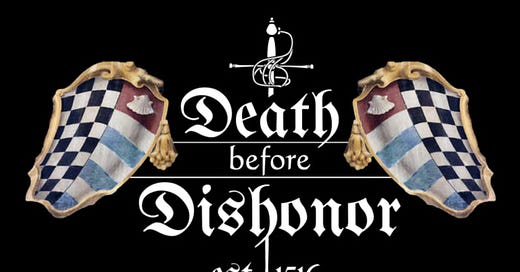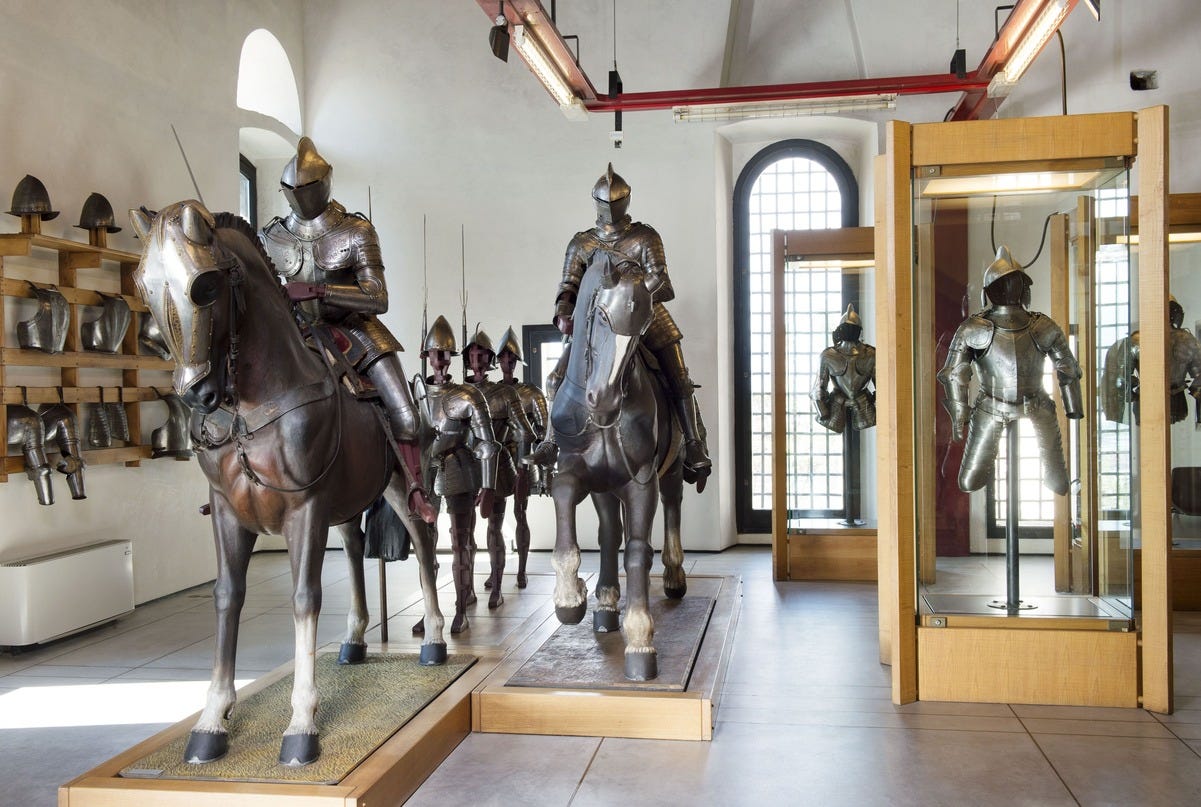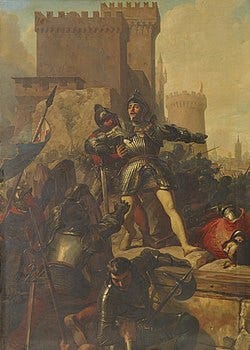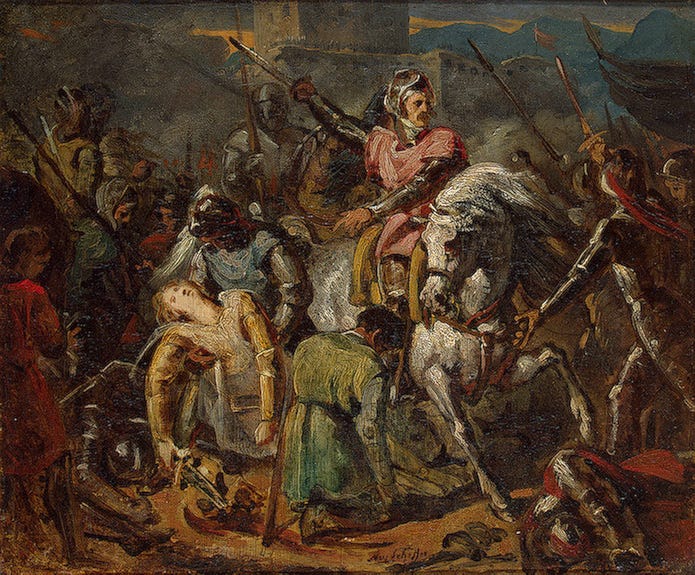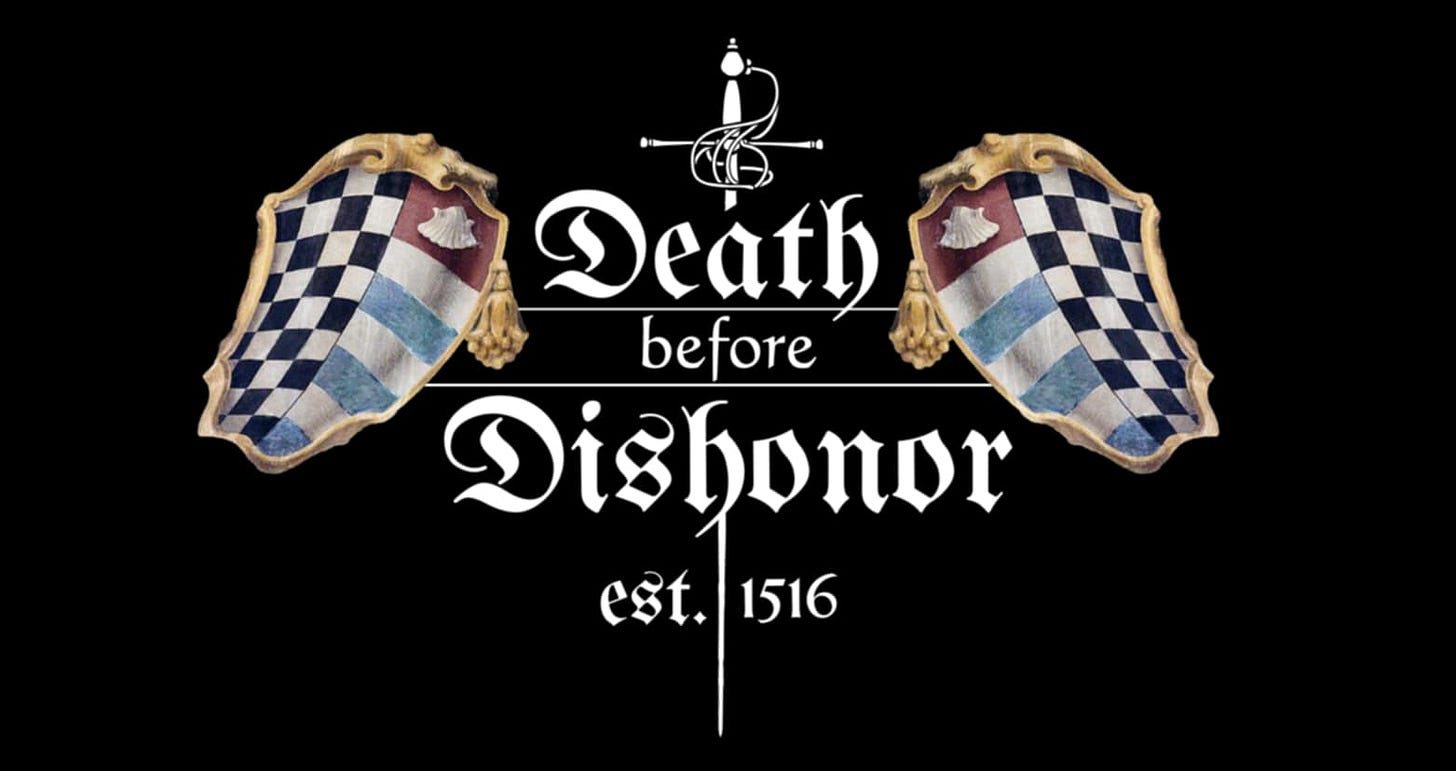

January of 1512 found Hugo Pepoli and Guido Rangoni serving at the heart of the Venetian army.
Hugo Pepoli was the right hand man of John Paul Baglioni, the supreme commander of the Venetian army. With Baglioni burdened by the dual weight of commanding the entire army and leading his own fearsome company of men-at-arms, the day-to-day reins of command often fell to Pepoli.
Guido Rangoni, meanwhile, had risen to become one of Venice’s most formidable captains. He led a powerful company of seventy-five lances, backed by a swift and deadly troop of mounted crossbowmen.[1] His name was bandied about in the highest levels of the Venetian government.
Venice was locked in a grinding war against both France and the Empire. Once again, her armies turned their eyes toward Verona—a prize they had failed to seize time and again since their triumph at the Siege of Padua two and a half years earlier. But Verona’s defenses held fast. No matter how many times the Venetians surged forward, the city refused to yield. By arms alone, Verona would not be taken.
Then, in February, a new path revealed itself—a chance for a new conquest that shimmered with equal parts opportunity and peril.
Brescia
In the early 1500s, no city in Italy produced finer arms and armor than Brescia, nestled near the storied lake country. Its master swordsmiths and ambitious merchants had grown “rich” and the city “opulent”, from the arms trade.[2] But in the bitter winter of 1512, the fleur-de-lis of France flew from the battlements, and the proud citizens of Brescia could hardly bear their occupier a day longer.
Just three years earlier, Brescia had thrived as one of the most loyal and prosperous cities of the Republic of Venice. Peace, order, and justice reigned under Venetian rule, and when the Republic called for funds to raise an army, none gave more—except Venice itself. But all that ended in May 1509, when French forces crushed the Venetian army at Agnadello and claimed Brescia for themselves.
The French occupation, marked by brutality and contempt, quickly wore out its welcome. Though plots and uprisings simmered, each was swiftly crushed by the iron hand of the strong French garrison. Yet beneath the surface, hatred festered.[3]
Then, in January of 1512, fate opened a door. The French commander—known as the Thunderbolt—had to strip Brescia’s defenses to reinforce Bologna. There the loyal French ally, the Bentivoglio family, faced annihilation at the hands of the Spanish. The Thunderbolt succeeded; Bologna was saved, the Spanish fled in disgrace.
But in Brescia, opportunity had arrived.
With the French garrison hollowed out, the people rose. Arms were gathered. A secret army was raised. And leading the charge was Louis Avogadro, who now turned to Venice, imploring the Republic to send its army and help liberate Brescia from the hated French yoke once and for all.
The Venetian Dilemma
For the Republic of Venice, the uprising in Brescia was more than a cry for help—it was a golden chance to strike a blow against the hated French and reclaim a city that had once been a shining jewel in the Venetian crown. But the opportunity came with a deadly risk.
Verona, still held by allies of France, lay between Venice and Brescia. This meant Brescia was not at the front—it was forty miles behind enemy lines. To march an army there was to plunge deep into hostile territory, exposed and vulnerable. One swift move from the enemy could sever the army from its reinforcements, leaving it stranded, surrounded, and doomed—like a rose dying on the end of a cut stem.
Yet wars are not won by caution. They are contests of will. And if Venice faltered now—if it turned its back on a loyal city begging to rise—what message would that send to the rest of the Republic? What would it say to the men who had pledged their lives and blades to the Lion of Saint Mark?[4]
Venice had faced darkness before. After the disaster at Agnadello, it was their bold, defiant assault on Padua that had rekindled hope. Now, once more, the Senate chose action.
They threw caution to the wind. They raised the war cry—“Marco! Marco!”—and let it ring across the plains of Lombardy.
Four hundred lances and a thousand light cavalry were dispatched to aid the rebels. United with the armed citizens of Brescia, this force surged into the city, drove out the French, and cornered the fleeing garrison in the fortified citadel.
Then came the next move—a strategy as bold as any blade. Venice coordinated with her Spanish allies to lure the French northward, straight toward Brescia. There, the trap would be sprung: a French army crushed between a Spanish hammer and a Venetian anvil.[5]
Between the Hammer and the Anvil
If Venice had tried to trap the French army between a Spanish hammer and a Venetian anvil, now it was the Republic’s own army—under Hugo Pepoli, Guido Rangoni, and John Paul Baglioni—that found itself caught between two unforgiving forces: the German garrison in Verona behind them, and the French hammer bearing down from Bologna.
That hammer was the Thunderbolt himself—Gaston de Foix—who now drove his army north with terrifying speed. His goal: to crush Baglioni’s force, which held the fragile lifeline connecting Brescia to the rest of the Venetian Republic.
Baglioni knew the French were coming. But like the Spanish before him, he underestimated their speed. In just two and a half days, Gaston’s men marched seventy miles over frozen terrain—a feat deemed impossible by all but the French. When the French hit they were closer to Brescia than the Venetians.[6]
The clash came at a river crossing in the pale light of early morning. French light cavalry reached the bridge first and seized it. The Venetians countered, throwing in their own light horsemen, and battle was joined at once.
Then came the French men-at-arms, with the legendary Chevalier Bayard at their head. Though he was sick and had been riding without armor, when he saw the fight unfolding he “shouted for a cuirass” and leapt into the fray.[7] With him charged the gendarmes of France, elite knights bred for war, slamming into the Venetian cavalry massed at the bridge.
Ordinarily, the Venetians would have been overwhelmed. But this time, they had artillery. Venetian guns roared to life, spitting fire and death into the charging French ranks, killing “a standard-bearer among others.”
Hugo Pepoli now led his own squadron of men-at-arms into the fight. Beside him, Guido Rangoni hurled his company at the French in carousels of twenty-five, lances lowered, striking hard and then wheeling back to regroup.[8] Crossbowmen on both sides darkened the sky with bolts, which, though mostly harmless to the knights in armor, struck deadly fear into the horses.
As the armored horsemen clashed, Venetian infantry advanced to support their cavalry. This was the Italian way of war: cavalry charging in waves, falling back to regroup behind a wall of infantry, and charging again. But the French gendarmes were Europe’s finest—numerous, relentless, and raised from birth to master the horse and the lance.
In several places, they smashed through the Venetian cavalry and surged into the infantry lines. To the foot soldiers—like those under Sebastian Manzino—the sight of a wave of ironclad horsemen galloping toward them must have seemed like a steel tide crashing upon the shore. Horses, snorting and foaming, bowled over men like toys. Even with pikes braced, the infantry could do little more than kill a horse or unseat a rider before being thrown into disarray.
To steady his men, John Paul Baglioni rode along the infantry lines, shouting above the din:
“They have no infantry with them! Hold fast, and we will carry the day!”
He was right. The French had come with cavalry alone. And so, inch by inch, the tide turned. With the Venetian infantry holding firm, the Venetian cavalry could retreat and reform behind them whenever needed. This gave them the ability to fight and win against the superior French armored cavalry. Though surprised, the Venetians were winning.
Then, in the distance, the Venetians saw the banners of approaching Gascon crossbowmen.[9] French infantry.
With the arrival of French infantry reinforcing their cavalry, the tide of battle turned sharply against Venice. The organized Venetian attacks in squadrons dissolved into a general melee. Now, the French gendarmes swung heavy maces, trying to crush Venetian skulls, while the Venetian men-at-arms desperately thrust swords into the joints of French armor or slashed at their horses.
Amid the chaos, Hugo Pepoli, Guido Rangoni, and Chevalier Bayard found themselves encircled—surrounded not just by knights but by infantry as well, all struggling to avoid being trampled in the mud by the raging warhorses.
One enemy infantryman lunged at Guido’s reins, slicing them and trying to drag him from the saddle.
Guido managed to wheel his horse and cut the man down, but the damage was done—his reins were severed. Realizing the peril, Guido scanned the swirling battlefield for an escape route, trying to guide his mount with just the pressure of his legs. But the battlefield was now all chaos, swirling eddies and tides of men, horses and deadly weapons.
The first to abandon the field were the Venetian infantry officers. With their officers on the retreat, the infantry quickly took to their heels. Though Hugo Pepoli and John Paul Baglioni fought furiously, when the collapse came, even they had to ride the wave of retreat.
Some of Guido’s men-at-arms saw their commander struggling, tried to reach him—but he was surrounded, trapped. Then came the final blow. As they watched, Guido fell from his mount into the mud. A French knight approached and threw a mighty blow with the mace into his skull.[10]
At that moment, Guido’s men knew it was over. There was nothing more they could do. They turned and fled.
The rout of Baglioni’s army was a disaster for Venice—especially in terms of infantry losses. The Fench cavalry chased them, and spent the rest of the morning play polo with the heads of the fleeing Venetian infantry.
The Venetian officers, escaped unscathed. As one observer bitterly noted: “All the infantry captains fled, mounted on their fine Turkish horses. In our time, it seems no longer dishonorable to own such horses—if only to make retreat easier.”[11]
Disaster
The rout of Baglioni’s army plunged Venice into crisis. The surviving infantry did not regroup—they scattered. Entire companies evaporated overnight, leaving commanders like Sebastian Manzino in charge of units that existed more on paper than on the battlefield. Instead of leading men into combat, Venice was now forced to send its infantry captains across the countryside to raise new troops from scratch.[12]
Cavalry losses were less catastrophic. Most of the light horse escaped the battlefield intact, and the Republic could take grim solace in the fact that only eighteen men-at-arms had fallen in the defeat.
But they deeply mourned one name: Guido Rangoni, “that noble, courageous, and honorable commander, who would have made a worthy captain.”[13]
Worse still, twelve thousand Venetian troops were now trapped in Brescia. While Baglioni, Pepoli, and what remained of their army limped east to recover and rebuild, the French were already on the move. The Thunderbolt—Gaston de Foix—turned his gaze toward Brescia and advanced with fury.
The citadel was still held by a French garrison, and now Gaston attacked it with all his might. What followed was a savage, desperate battle. The people of Brescia fought like cornered animals. Even the women hurled stones, roof tiles, and pots of boiling water from the rooftops in a last, furious stand. But their courage was no match for the French onslaught.
The Venetian garrison, by contrast, showed far less resolve. Among them was Antonio Pio, a man better known for leading from the front only when it was time to retreat. As the French stormed the castle, Pio and a large portion of the Venetian cavalry opened the gates—not to fight, but to flee, thundering out of the doomed city to save their own skins.
With the garrison gone, Brescia was lost. And the sack that followed was unspeakable.
The French looted everything of value, hauling away an estimated four million ducats in treasure. The citizens were butchered by the thousands, their corpses stacked like woodpiles. The stench of death choked the city. Louis Avogadro, the brave leader of the rebellion against French rule, was captured. They tried to execute him with a dull sword. It failed. Dying in agony, Avogadro seized the blade and slit his own throat, choosing his own end over more torture.
When it was over, the “rich” and “opulent” city—famed for its smiths and artisans—was gone. So complete was the devastation that Brescia would never reclaim its former greatness.
And yet, Gaston de Foix was not finished. Brescia had been merely a diversion—a brutal sideshow. With blood still on his boots, the Thunderbolt now marched east, aiming to strike the Spanish army that had slipped from his grasp at Bologna.
“Not Quite Dead Yet”
Word had spread that Guido Rangoni had fallen in battle—but the reports were false. Though wounded and taken prisoner by the French, Rangoni was very much alive. From captivity, he called in favors, borrowing from friends and family until he gathered the 600 ducats demanded for his ransom. Upon his release, he returned swiftly to Venetian service, securing an advance on his pay to repay his creditors.
Venice, impressed by his audacity and tenacity, rewarded him. The Republic expanded the authorized strength of his company to 100 lances—a mark of honor, though Rangoni would never quite manage to fill all those posts.
Meanwhile, Hugo Pepoli had troubles of his own. As second-in-command to John Paul Baglioni, the Captain General of the Venetian army, much of the burden of command fell to him. Baglioni, ever distracted by earthly pleasures, had become thoroughly infatuated with a striking woman from Padua. While the army attempted to rebuild after recent setbacks, its commander was content to linger in the haze of romance.
And so, while Venice lingered in recovery, the French—led by the formidable “Thunderbolt”—marched east. Their target: the Spanish army. Venice, bruised and rebuilding, could offer no aid to her allies as the French juggernaut advanced.
The stage was set for a bloody reckoning. The plains around Ravenna would soon bear witness to one of the most cataclysmic battles of the Italian Wars. The armies of France, Spain, and the Papal States converged, and the ground would soon be soaked in blood.
Though neither Guido Rangoni nor Hugo Pepoli fought in the Battle of Ravenna, its outcome would lead to their eventual duel. For Hugo, it was personal—his own brother, Romeo Pepoli, served as a captain of light cavalry in the Spanish ranks.[14]
Battle of Ravenna
After shattering the Venetian army into splinters, the Thunderbolt—Gaston de Foix—turned his victorious French legions toward Romagna, the fertile heartland southeast of Bologna. These lands belonged to the Pope, but their cities fell quickly before the thunder of his advance. Only the coastal towns, linked by the Adriatic and bound to Venice, dared resist.
Next, the Thunderbolt set his sights on Ravenna. Pressured by the King of France to force a decisive confrontation with Spain—before the looming threat of war with England could draw French strength away—he moved swiftly. The Spanish, reluctant to risk open battle, tried to avoid engagement. But Pope Julius II, desperate to protect Ravenna, insisted they stand and fight.
So the Spanish commander formed a defensive line just outside the city, anchoring one flank on a river. Knowing the French outnumbered them, they did not simply wait in the open. They turned to the spade. Trenches were dug for the infantry—broad, deep, and cruel—to blunt French cavalry charges and shield men from artillery fire. Spiked carts and scythed wagons were rolled into position for added protection.
Behind the trenches, the heavy cavalry waited in reserve. Romeo Pepoli, brother of Hugo, served with the light cavalry, posted on the exposed flank—where the first blow might fall.
This was a familiar pattern. Ten years earlier, Spanish forces had used fortifications and firearms to crush a larger French army. But the Thunderbolt had learned that lesson—and he had no intention of repeating their mistake.
Like the Spanish, he placed his infantry in front, with armored cavalry to the rear and light horse on the flank. But this time, the trap would not spring so easily. Rather than send his Gendarmes headlong into the trenches, the Thunderbolt devised a more clever plan: draw the Spanish out.
For the French were allied were allies with the Duke of Ferrara, the great cannoneer of Italy. And he had brought his guns to the fight.
He stationed the Duke of Ferrara and his formidable artillery on the Spanish flank, protected by the river. From there, the guns could fire enfilade the Spanish position—raking the length of the Spanish line, raising hell.
As cannonballs flew threw the Spanish position, or rolled like deadly bowling balls on the ground, the Spanish commander came up with a solution. He ordered his men forwards into the ditches and ordered them to lie down. This greatly minimized the casualties that the Duke of Ferrara and his deadly artillerists could cause.
The Spanish cavalry on this flank had no such protection. Cannonballs screamed overhead and smashed into their ranks. Artillery fire was the great equalizer on the Renaissance battlefield: armor did not resist it, and it made the steel-encased knights as vulnerable as the infantrymen they often despised. The Duke’s cannons tore soldiers and horses apart, severed heads and limbs and tossed them into the air. Cries of pain echoed across the field.
Still, Navarro, the Spanish commander, refused to move and engage the French. He wanted to fight them on his own terms. He ordered his men to hold position and wait for the French assault. But discipline cracked. The Spanish cavalry could not just sit there and take it until they were all dead.
They spurred their horses and thundered forward towards the French men-at-arms.
Seeing that control was slipping, Navarro ordered a full attack. He threw his infantry forward, trusting their grit and training to win the day.
And so began the terrible collision. The finest infantry in Europe met the most fearsome cavalry on the continent. The Thunderbolt led the Gendarmes himself, smashing into the Spanish light horse and their Italian allies. Romeo Pepoli died leading his men into that steel tempest. Nearby, Malatesta Baglioni—son of Venice’s Captain General—fought like a demon, suffering twenty-two wounds and losing forty-three horses beneath him, but somehow surviving.[15]
The French cavalry triumphed, driving the Spanish horse from the field. But elsewhere, the battle was far from over.
Where Spanish infantry clashed with German Landsknechts and Gascon mercenaries, the Spanish held the upper hand. Once the pikemen at the front of each formation became locked together, the Spanish could move their rodeleros forward. These were swordsmen armed with round shields known as a rotella. In the deadly "push of pike” these swordsmen crept forward around the bristling hedge of spears. Their blades flashed from beneath iron shields, cutting down enemy pikemen in close quarters.
The landsknechts and Gascons had no anwer for this and the Spanish infantry minced their enemies like they were making chorizo. Spain was once again poised to repeat its triumph from ten years before and drive the French from the field.
But then the French cavalry returned.
With the enemy cavalry routed, the Thunderbolt unleashed his armored horsemen against the Spanish infantry—who were still entangled in combat. The Spanish were scattered: swordsmen, musketeers, and pikemen jumbled together. They could not form the tight pike squares needed to repel cavalry.
The Gendarmes thundered in.
Though stunned by the charge. The armored French horses sent the Spaniards flying, and now it was the Spanish who were being cut up. Yet to the credit of their professionalism, the Spanish reformed. Not with any hope of staving off defeat – that ship had sailed. But by retreating in formation with pikes at the edges of the square, they prevented the wholesale slaughter that was the typical rule for defeated groups of infantry.
The Thunderbolt was frustrated and sent his men on another charge at the retreating infantry.
He led a final charge into the rear of the Spanish infantry. But this time, it was the French who were caught. Surrounded, the Thunderbolt fell. Some say he was thrown from his horse. Others say the beast toppled on him mid-fight. A lance pierced his side, and the hero of France was dead.
The battle ended soon after. The surviving Spanish infantry were allowed to withdraw, harried by peasant mobs as they marched one hundred miles in retreat. The Pope and the King of Spain had lost two-thirds of their forces. The Spanish army was broken and demoralized, incapable of further resistance for months.
The French had won—but it was a hollow victory. One-third of their own army lay dead or crippled. Their captains were slain, their cavalry shattered, their army scattered in the chaotic sack of Ravenna. Even the victors felt defeated.
The Chevalier Bayard captured the mood in a letter home:
“If the King has won the battle, I assure you we have lost it. All grief and mourning that has ever been could not equal that which reigns—and still reigns—in our camp.”
With the Pope’s army in ruins, the Spanish in flight, and the Venetians licking their wounds behind fortress walls, Italy seemed to fall into France’s lap. From the Mediterranean to the Adriatic, the French held sway. In Rome, panic spread. Julius II and his cardinals feared the French might soon march on the Vatican itself.[16]
In a quiet corner of the Venetian camp near Vicenza, Hugo Pepoli and Guido Rangoni watched the storm sweep across Italy—and wondered if Venice would be next.
[1] Technically, Guido’s younger brother was in charge of the mounted crossbowmen, but this has been his company for a long time and the mounted crossbowmen almost certainly worked as scouts for his company of men-at-arms.
[2] Guicciardini, pp. 975-976.
[3] Mallett & Shaw, p.117
[4] Da Porto pp.254-265 movingly describes the awareness of this situation and reluctance on the part of Andre Gritti, future Doge of Venice to support Brescia as well as the Bresicans’ own awareness of the danger inherent in the rebellion.
[5] Sanuto, Vol. XIII, cols. 473-474.
[6] Da Porto, pp. 292-294
[7] Shellaberger
[8] This is suppositional. Though both men were at the battle with their companies, there actions there can only be guessed at from the tactics of the time as well as the general progress of the battle.
[9] Da Porto, pp.269-270
[10] This is but a guess. Though we know Guido Rangoni was unhorsed due to his reins being cut, and that he was wounded we don’t know that he was wounded by a mace.
[11] Da Porto, p.272.
[12] Sanuto, Vol XIII, cols. 504-505.
[13] www.condottieridiventura.it, entry “Guido Rangoni, February 1512”
[14] His role in the Spanish army is based on conjecture. We know that he was serving as a Spanish captain, and that he was not listed among the captains of infantry. He had never commanded a force of men-at-arms before and did not have the prestige to do so. Most likely then he was serving as a captain of light cavalry.
[15] See condottieridiventura.it entry for “Malatesta Baglioni’
[16] There are many sources that describe this famous battle. I drew primarily from Guicciardini, pp.983-1002 and from Sanuto Vol 14, as well as for the French perspective from La très joyeuse et très plaisante histoire du gentil seigneur de Bayart.

